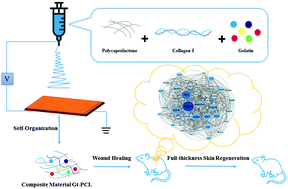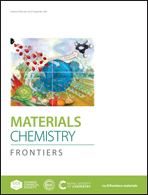Self-organizing gelatin–polycaprplactone materials with good fluid transmission can promote full-thickness skin regeneration†
Abstract
Healing, reconstruction and recovery after skin injury have long been a major field of research, and many biomaterials have been designed for skin healing treatment. Because the skin repair process includes a series of complex processes such as hemostasis, inflammatory reactions and tissue remodeling, the microenvironment for bionic cell growth is particularly important. Herein, we used the self-organization effect of natural polymer materials to simulate the extracellular matrix, and prepared a structure-stable gelatin–polycaprplactone (Gt–PCL) through high-voltage electrospinning technology and a multiphase method. The composite material was capable of phase separation and showed a superior water retention rate and good fluid transmission effects in vivo and in vitro, which was used in repairing tests after full-thickness skin excision in rats. Gt–PCL materials showed not only good biocompatibility but also appropriate mechanical properties to effectively improve the epidermal healing rate and prevent wound expansion. RNA-sequencing and differential expression analysis showed that the polycaprolactone biomimetic formed a stable multi-stage, micro–nano composite structure with various soluble amino acids or proteins through self-organization. This material was able to repair the skin by up-regulating tissue repair-related genes, initiating neural repair and hair regeneration pathways and down-regulating the immune response and stress response-related pathways, thus avoiding secondary injury and excessive wound repair. Moreover, Itgax, a key mRNA associated with wound healing, was identified and has been shown to affect the immune and barrier profiles of the skin. Together, these results demonstrate that Gt–PCL materials promote full-thickness skin regeneration, and may have good clinical effects and potential application value in the future.

- This article is part of the themed collection: Recent Open Access Articles in Frontiers Journals


 Please wait while we load your content...
Please wait while we load your content...